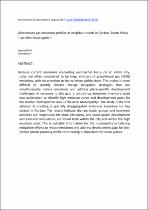 ResearchSpace
ResearchSpace
Greenhouse gas emissions profiles of neighbourhoods in Durban, South Africa – an initial investigation
JavaScript is disabled for your browser. Some features of this site may not work without it.
- ResearchSpace
- →
- Research Publications/Outputs
- →
- Journal Articles
- →
- View Item
| dc.contributor.author |
Jagarnath, M

|
|
| dc.contributor.author |
Thambiran, Tirusha

|
|
| dc.date.accessioned | 2017-09-01T09:34:49Z | |
| dc.date.available | 2017-09-01T09:34:49Z | |
| dc.date.issued | 2017-08 | |
| dc.identifier.citation | Jagarnath, M. and Thambiran, T. 2017. Greenhouse gas emissions profiles of neighbourhoods in Durban, South Africa – an initial investigation. Environment & Urbanization, doi.org/10.1177/0956247817713471 | en_US |
| dc.identifier.issn | 0956-2478 | |
| dc.identifier.uri | doi.org/10.1177/0956247817713471 | |
| dc.identifier.uri | http://journals.sagepub.com/doi/abs/10.1177/0956247817713471 | |
| dc.identifier.uri | http://hdl.handle.net/10204/9521 | |
| dc.description | Copyright: 2017 International Institute for Environment and Development (IIED). Due to copyright restrictions, the attached PDF file only contains the abstract of the full text item. For access to the full text item, kindly consult the publisher's website. | en_US |
| dc.description.abstract | Because current emissions accounting approaches focus on an entire city, cities are often considered to be large emitters of greenhouse gas (GHG) emissions, with no attention to the variation within them. This makes it more difficult to identify climate change mitigation strategies that can simultaneously reduce emissions and address place-specific development challenges. In response to this gap, a bottom-up emissions inventory study was undertaken to identify high emission zones and development goals for the Durban metropolitan area (eThekwini Municipality). The study is the first attempt at creating a spatially disaggregated emissions inventory for key sectors in Durban. The results indicate that particular groups and economic activities are responsible for more emissions, and socio-spatial development and emission inequalities are found both within the city and within the high emission zone. This is valuable information for the municipality in tailoring mitigation efforts to reduce emissions and address development gaps for low-carbon spatial planning whilst contributing to objectives for social justice. | en_US |
| dc.language.iso | en | en_US |
| dc.publisher | SAGE Publications Ltd | en_US |
| dc.relation.ispartofseries | Worklist;19404 | |
| dc.subject | Greenhouse gas emissions | en_US |
| dc.subject | Climate change mitigation | en_US |
| dc.subject | Climate justice | en_US |
| dc.subject | Neighbourhood scales | en_US |
| dc.subject | Durban metropolitan area | en_US |
| dc.title | Greenhouse gas emissions profiles of neighbourhoods in Durban, South Africa – an initial investigation | en_US |
| dc.type | Article | en_US |
| dc.identifier.apacitation | Jagarnath, M., & Thambiran, T. (2017). Greenhouse gas emissions profiles of neighbourhoods in Durban, South Africa – an initial investigation. http://hdl.handle.net/10204/9521 | en_ZA |
| dc.identifier.chicagocitation | Jagarnath, M, and Tirusha Thambiran "Greenhouse gas emissions profiles of neighbourhoods in Durban, South Africa – an initial investigation." (2017) http://hdl.handle.net/10204/9521 | en_ZA |
| dc.identifier.vancouvercitation | Jagarnath M, Thambiran T. Greenhouse gas emissions profiles of neighbourhoods in Durban, South Africa – an initial investigation. 2017; http://hdl.handle.net/10204/9521. | en_ZA |
| dc.identifier.ris | TY - Article AU - Jagarnath, M AU - Thambiran, Tirusha AB - Because current emissions accounting approaches focus on an entire city, cities are often considered to be large emitters of greenhouse gas (GHG) emissions, with no attention to the variation within them. This makes it more difficult to identify climate change mitigation strategies that can simultaneously reduce emissions and address place-specific development challenges. In response to this gap, a bottom-up emissions inventory study was undertaken to identify high emission zones and development goals for the Durban metropolitan area (eThekwini Municipality). The study is the first attempt at creating a spatially disaggregated emissions inventory for key sectors in Durban. The results indicate that particular groups and economic activities are responsible for more emissions, and socio-spatial development and emission inequalities are found both within the city and within the high emission zone. This is valuable information for the municipality in tailoring mitigation efforts to reduce emissions and address development gaps for low-carbon spatial planning whilst contributing to objectives for social justice. DA - 2017-08 DB - ResearchSpace DP - CSIR KW - Greenhouse gas emissions KW - Climate change mitigation KW - Climate justice KW - Neighbourhood scales KW - Durban metropolitan area LK - https://researchspace.csir.co.za PY - 2017 SM - 0956-2478 T1 - Greenhouse gas emissions profiles of neighbourhoods in Durban, South Africa – an initial investigation TI - Greenhouse gas emissions profiles of neighbourhoods in Durban, South Africa – an initial investigation UR - http://hdl.handle.net/10204/9521 ER - | en_ZA |





